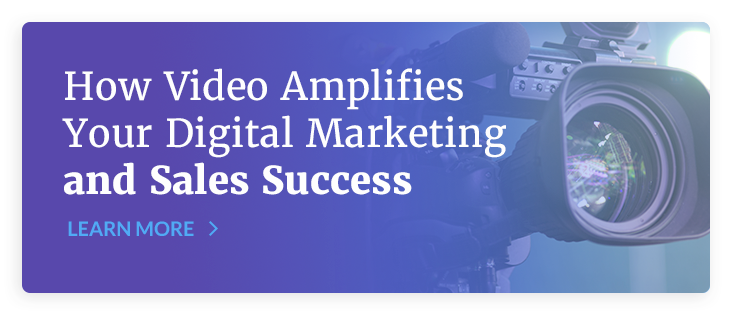
What Makes for Great B2B Video Marketing?

B2B video marketing may not get as much attention as commercials for household name brands, but it can be just as powerful.
Dr. James McQuivey of Forrester Research famously wrote that one video is worth 1.8 million words in a study predicting video marketing would take over the world — and that was almost 15 years ago, before nearly every B2B company was investing in it. The logic behind his statement is that images create strong associations in our mind, and videos have the potential to pack thousands of images into just a few seconds. Add some dramatic music and audio elements, and marketers can evoke an entire mood in a moment.
It’s not surprising, then, that video content has become a key element of B2B marketing strategy. Most marketers agree video is effective at generating brand awareness. Many also say it helps them with lead generation and improving their sales processes.
In this post, we’ll uncover what makes B2B video marketing effective and share some examples of videos and strategies that drive results.
Understanding the Target Audience: B2B Video Marketing Statistics
Seventy-five percent of B2B buyers now prefer to make purchasing decisions without directly talking to sales reps, according to the latest Gartner research. Instead, these buyers are increasingly relying on videos, comparison guides and customer reviews to help them understand products and services and validate them as the right solution.
The latest survey by Content Marketing Institute found 94% of enterprise content marketers used video content in the past year, compared to 62% who used whitepapers and just 44% who used research reports. Among those marketers, 54% reported that video was the most effective type of content. Other video marketing statistics you should know:
- More than 91% of consumers said they watched an explainer video to learn more about a product or service, according to Wyzowl’s latest survey
- Explainer videos and social media videos are the most popular formats, according to the same report
- 90% of marketers say they've seen a positive ROI from video marketing, according to Wyzowl
- The most common video length in 2023 was 5-30 minutes, according to Wistia’s 2024 State of Video report.
- Wistia also found videos that were 30-60 minutes (the length of a typical webinar) had an average play rate of 50% — meaning half of all those who saw the video clicked on it — while videos longer than one hour had a rate of 58%
- Videos less than five minutes had significantly lower play rates, according to Wistia; the best play rate for shorter videos was 23% for videos less than one minute
- 59% of companies now use AI to generate video transcripts, per Wistia, and 66% say they plan to use AI for other elements of their video projects, such as script writing and editing
Unlike videos for consumer products, B2B video marketing showcases operational benefits to what is often a committee of decision-makers, rather than a single buyer. While the approach is distinct, that doesn’t mean B2B videos have to be boring or lacking emotion.
The best B2B videos are clear, engaging, and compelling enough to resonate with their target audience.
One example is this Who We Are video for e2Companies, a company providing innovative solutions for power generation, distribution and energy economics. The video is primarily targeting large energy consumers, including facilities managers in retail, manufacturing, commercial buildings, healthcare and government. It offers a quick glimpse at how our need for electricity has evolved and how e2Companies is accelerating the path to a new energy future.
Customizing B2B Video Marketing Content
While videos for many well-known products tend to focus on brand awareness (Reese’s Peanut Butter Cups or Doritos need no introduction) B2B videos often need to do more heavy lifting to help viewers understand the value of what they’re selling.
That doesn’t mean they should feel heavy.
Ideally, a B2B brand video should focus on just one specific pain point and show how the product or service eliminates it.
For instance, many chiropractors have too much paperwork distracting them from being fully present with their patients and keeping them at the office late at night.
A brand awareness video for chiropractic back office software should clearly show what’s at stake (the potential for burnout) and what a chiropractor can do as a result of using the software (spend more time treating patients and growing the practice.)
The initial brand video should highlight a few key benefits and clearly state your value proposition, while a more detailed explainer video offers a closer look at how the software works.

Demonstrating Your Value Proposition
Video marketing helps B2B brands communicate their value proposition and what sets them apart from competitors. Video’s dynamic nature allows companies to communicate complex ideas in an understandable and engaging way, which is crucial in the B2B space.
Consider the software sector. Many companies will claim their solution is easier to implement and more user-friendly. This could actually be a key part of their value proposition, but it’s difficult to prove that without showing how easy it is to find something and take action with one click.
Video helps your brand build its case and demonstrate the value of each feature.
Slack’s introductory video, “What Is Slack?” showcases the benefits of the platform while giving users a glimpse of how it works. Without this quick overview video, it would be difficult to understand how the platform can be so valuable in streamlining communications, or why it’s preferable to all their competitors.
Videos also naturally lend themselves to telling stories that are more interesting to watch than they might be to read. You probably wouldn’t spend much time reading an article about communication challenges within a company, but you might stop to watch a specific, relatable example illustrated through a video in your LinkedIn feed. You might even comment on it or share it with someone else.
Building Trust With Video Marketing
The B2B sales cycle can be long, involving months of evaluation, consideration and approvals from executives and other stakeholders, like IT directors and employee end users.
The person leading the search for a solution may be convinced, but they also need to overcome potential objections from others within the organization. Other types of video content can support those later stages of the buyer’s journey, making them an essential part of your marketing strategy.
For instance:
- A company culture video offers a behind-the-scenes glimpse at your team, humanizing your brand and supporting recruitment efforts
- More technical explainer videos can help potential buyers understand if your solution will work with their existing technology or processes
- Thought leadership videos recorded from webinars or conferences to showcase your company’s expertise
- Customer testimonial videos build trust and reach your audience on a more emotional level
- Videos featuring industry partners or “power users” also enhance credibility among an existing audience
- Welcome videos and tutorials help improve user adoption among existing customers, supporting retention
ClickUp is a good example of a B2B company that uses engaging tutorial videos to support its onboarding process. The videos are short and specific, helping the user learn the ecosystem as they go without overwhelming them.
See more great video marketing examples here.
B2B Video Marketing Strategy: Distribution and Promotion
After spending considerable time and resources creating B2B videos, it’s just as important to distribute and promote them properly to maximize their impact.
Here are a few places to consider for video distribution:
Hosting video on your website
A video embedded on your site continuously engages visitors. A strong, eye-catching video can do a lot of the heavy lifting on your homepage, introducing people to your brand. You can tailor videos to specific topics, introduce your company, or showcase customer testimonials, which can be particularly effective in quickly building trust and demonstrating success.
According to Vidyard, 86 percent of business-related video views occur on desktop browsers, indicating a significant opportunity to capture the attention of your target audience while they're at work.
If your website is hosted on a platform that offers robust video analytics (such as HubSpot), you may want to consider directly uploading it there.
Otherwise, you may need to use a third-party platform, such as Vimeo or Wistia, so you can measure performance.
Promoting video with email marketing
Incorporating video into your email marketing can amplify engagement and boost purchase intent. Videos offer a dynamic way to complement new product announcements. You can link to further content, embed the video directly, or include a strong call to action.
Embedding video in blog posts
Just as in emails, videos can enhance your blog content. Embedding a video that aligns with a post topic can provide additional depth and insight, making complex information more accessible and engaging. This approach not only enhances the visitor's experience but also increases the time they spend on your site, which can positively affect search engine rankings.
Adding videos to landing pages
A short video offering a glimpse at your solution right from your landing page can entice prospective customers to schedule a demo or a consultation.
Promoting videos on YouTube
As the second most popular search engine and de facto social network, YouTube offers incredible potential for marketing video distribution. By maintaining an active YouTube channel, you not only reach a global audience but also create pathways that can lead viewers back to your website. YouTube is essential for extending your reach and enhancing your brand’s visibility online.
Using video in your social media strategy
Video is a great way to raise brand awareness among your social media followers. Whether you primarily use Facebook, LinkedIn, Instagram or other social media channels, uploading videos directly to the platform improves visibility and engagement because the algorithms favor interactive content that keeps people there longer.
You may need to adjust your video format to meet the guidelines of individual platforms and add closed captioning if the platform doesn’t automatically generate it.
Promoting your brand at trade shows
Videos displayed at your trade show booth can attract attention and draw people in.
A well-crafted video can be an effective conversation starter, helping you engage with potential customers passing by and leaving a memorable impression.
By strategically using these distribution methods, you can ensure that your B2B videos reach the right audience, deliver your message effectively, and ultimately drive business results.

Measuring B2B Video Marketing Success
You may have the most eye-catching, engaging video, but how do you know if anyone is watching it or if it's making an impact?
There are several KPIs that provide valuable insights into how videos are contributing to your marketing goals. While the number of views is an obvious indicator of your video content’s reach, other metrics like average viewing time are crucial for understanding engagement levels. This metric helps marketers determine at which points viewers lose interest or stop watching, which can inform content adjustments to better maintain viewer interest. Tracking the time spent on a page with an embedded video can also help you understand how the video contributes to overall engagement on your site.
Don’t forget to include the number of impressions, clicks and shares for social posts featuring your videos as well. This is one KPI that may be easy to overlook since your videos will likely be uploaded directly, potentially to several different channels, but it’s an important one to include because YouTube is just one of many channels to consider.
Ultimately, videos hosted on other channels should be driving traffic back to your website, so don’t forget to factor this in as you analyze organic search traffic and social posts. You may want to consider using calls to action with vanity URLs or separate tracking codes so you’ll know which traffic actually came from the video compared to all other social and organic searches. Annotation links with clickable text and email capture forms are other common ways to improve conversions from videos, with 41% of video marketers using these features, according to Wistia.
An effective B2B video marketing strategy should build in time to regularly analyze these metrics and use A/B testing to optimize for various channels. Your team’s willingness to experiment will help you fine-tune your B2B video marketing strategy. By testing different video lengths, you can ensure you’re maintaining interest.
Testing different calls to action is another way you can make continuous improvements.
Viewers may not be ready to schedule a demo after watching an overview video and may need a secondary call to action, such as completing a two-minute assessment or watching a more in-depth product demo video that’s behind a form. If you’d rather not gate your demo video, you can retarget those who visit that page with ads directing them to something else, like a case study.
Regularly reviewing these metrics and adapting your strategy will help you continue to create video content that resonates with potential customers and drives real results.
Supercharge Your Strategy With a B2B Video Marketing Agency
Even if you’re among the lucky third of companies that have some in-house capabilities to create brand videos, you probably don’t have an in-house team that can handle all your video production needs. There’s a good chance you’ll need additional support when it comes to writing video scripts, filming on-site events, video editing or optimizing video distribution.
Hiring a video marketing agency is the fastest way to assemble a team of experts able to create compelling videos quickly. There are many agencies and freelance videographers who specialize only in one area, like video production. You might have to hire several different ones to meet your needs, and that might exceed your video budget.
While this might accomplish your short-term goals, it may not be the best way to build a sustainable video marketing strategy.
As a full-service digital marketing agency with expertise in video, Kuno Creative delivers much more than your next video project. We’ll take the time to understand your company’s broader goals and develop a comprehensive marketing campaign strategy that includes video as well as other audio and visual elements. We can help you determine the best way to incorporate video into your existing website, email marketing strategy, content calendar and events marketing.
We’ll also recommend the best way to amplify brand awareness and lead generation by using video on social media platforms and paid advertising. And we'll help your team measure the return on your video content strategy with lead scoring, revenue operations support for your sales and marketing teams, and more.
Take some time to review some of our video marketing examples, and schedule a consultation when you’re ready to talk about your needs and goals for video and your business.




